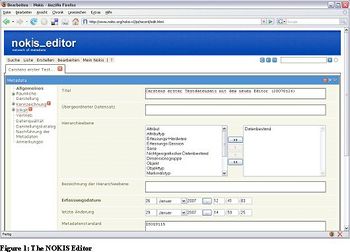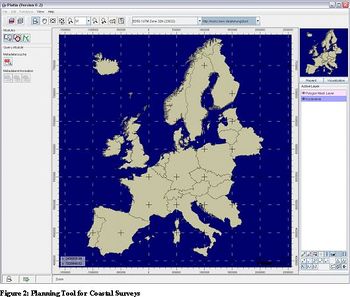NOKIS - Information Infrastructure for the North and Baltic Sea
This article describes the background, development and applications of NOKIS. NOKIS is an information system for the North and the Baltic Sea. Another related article is the development of a geographical dictionary in the context of NOKIS. The NOKIS information system for the North and the Baltic Sea can be accessed through the MDI-DE portal.
Contents
Introduction
The initial motivation for the project NOKIS (German title: Nord- und Ostsee-Küsteninformationssystem) was the lack of an infrastructure for the exchange of geodata across administrative boundaries between the German Wadden sea national parks and other governmental administrations (e.g. water management and administration of waterways and navigation) on the federal and state levels. Today, around 20 partners from administration, research and industry are cooperating within NOKIS. The focus of the participants shifted from the mere goal of an information system toward the shared internet-based use of existing geodata. The technologies and concepts of NOKIS reflect the common objectives of the participating partners, but they also have expanded due to alternate interests, problems and tasks. Some of the frequently discussed topics in the project since its start in the year 2000 are data and privacy protection, criteria for the distribution of data and the handling of the copyright of data. The micro-cosmos of federalism in Germany can be seen as a biotope, in which the tasks, problems and their handling of the data exchange across institutional and administrative boundaries can be studied. The first steps have been completed to establish NOKIS as an institution.
Use of Standards
Since its establishment, NOKIS made use of existing and emerging standards. In the field of geodata, the ISO 19100 suite of standards concerning the standardization of metadata is already the de-facto standard for the erection of new geodata infrastructures (GDI). The NOKIS network especially uses the parts IS 19115 (ISO 2003[1]) for metadata about geodata, IS 19119 (ISO, 2005[2]) for metadata about services and TS 19139 (ISO, 2007[3]) for the implementation in XML schema. In the developing network of different GDIs, the use of exchange standards is vital for the interoperability of systems. NOKIS contributes to the interoperable network by using standards from the Open Geospatial Consortium (OGC) and from the German implementation of the OGC ISO Application Profile for CSW (Catalog-Service for Web; Open Geospatial Consortium, 2005[4]) named DE-Profile (Länderübergreifender Arbeitskreis Metadaten, 2005[5]). Within NOKIS, a profile of the ISO 19115 has been developed, which meets the needs of the coastal community. To enable the documentation of time series and research projects within the same system, metadata schemas have been developed to include the necessary information.
NOKIS Applications
Editor
The NOKIS Editor is the central tool for the generation and maintenance of metadata records. This software helps the user in creating valid ISO 19115/19119 metadata by indicating missing or wrong elements and by providing aids for the editing of certain elements. It aids the user by offering template mechanisms for the generation of metadata for similar data sets as well as offering the possibility to import metadata from other applications (e.g. ESRI ArcGIS Metadata).
A workflow mechanism is included in order to make the software manageable in a context of greater institutions. It allows for the restriction of the visibility and of the editing functions by the administrator. A context-sensitive help system is incorporated, which supports the editor in the creation of the necessary metadata elements. The experience in the first NOKIS project (2001-2004) showed that the modern metadata standards are far from being intuitively comprehensible.
The software is implemented as a 3-tier Java application, which uses a browser as front-end. Any up-to-date graphical web browser should be working, it is tested with Mozilla Firefox 2.0.* and Internet Explorer 6.0 upward. The server-side implementation is based on the Spring-Framework for web applications (Spring 2007[6]), which provides a flexible basis for the integration of different components for the persistence, application logic or the view generation. The view is generated using Apache MyFaces and different libraries which provide special implementations for the Java Server Faces specification (Burns 2006[7]).
Planning tool
One applications within NOKIS that draws a lot of attention is the Planning Tool. It exists in different customizations: as a planning tool for the coastal survey planning and as a monitoring network planning tool for the Water Framework Directive (European Parliament, 2000[8]). The Planning Tool offers the user a Rich Client Frontend for the generation of planning information. It allows data import from various GIS formats and stores its information in a configurable NOKIS metadata repository, making it searchable for other applications, using the CSW interface.
Services
Catalogue Services
The NOKIS infrastructure uses OGC Catalogue Services for the data exchange between different NOKIS metadata nodes or with other GDIs. The CSW interfaces delivers DE-Profile and NOKIS conform metadata. Through the use of this standardized interface, all services can operate with the same technology. With the upcoming release of the NOKIS software in version 2, a NOKIS instance will provide an OGC CSW interface for the OGC ISO Application Profile 1.0, ensuring an easy integration with existing infrastructures.
Coordinate Transformation Service
NOKIS provides a web service for the transformation of coordinates between different systems. It is based on the freely available projection library PROJ.4. It offers the possibility to transform point coordinates between known and describable cartographic projections. A web service for the transformation of complete ESRI shape files is planned for the summer of 2007. It also uses the projection library PROJ.4 and will be accessible for the partners of the NOKIS project.
Tools to Analyse and Present Data
While NOKIS contains metadata of coastal data, a direct link to the datasets could be stored and associated with services for presentation and basic analyses. For this, a collection of tools will be prepared. Geodata could be displayed by Web-Map-Services, measurements of wind could be explored with an interactive tool. Other services will be added to this toolbox after an examination the primary requirements of the partners community.
Coastal Gazetteer
A coastal gazetteer is being developed in NOKIS to support users in retrieving and describing spatial information.
See also
Internal links
- Development of a geographical dictionary in the context of NOKIS
- Water Framework Directive
- European Marine Strategy Framework Directive
External links
The NOKIS information system for the North and the Baltic Sea can be accessed through the MDI-DE portal.
References
- ↑ International Organization for Standardization (2003): IS 19115:2003. Geographic information – Meta-data.
- ↑ International Organization for Standardization (2005): IS 19119:2005. Geographic information – Services.
- ↑ International Organization for Standardization (in prep. 2007): TS 19139:2006. Geographic information - Metadata - XML schema implementation.
- ↑ Open Geospatial Consortium (2005): ISO19115/ISO19119 Application Profile for CSW 2.0. OGC Recommendation Paper Version 0.9.3.
- ↑ Länderübergreifender Arbeitskreis Metadaten (2005): DE-Profil des ISO19115/ISO19119 Anwendungs-profils für OGC Web Catalogue Services (CSW-2.0).
- ↑ Spring (2007): Spring Framework
- ↑ Burns, E., Kitain, R. (2006): JavaServer Faces Specification. Version 1.2 - Rev A.
- ↑ European Parliament (2000): Directive 2000/60/EC of the European Parliament and of the Council of 23 October 2000 establishing a framework for Community action in the field of water policy, Official Journal L 327, 22/12/2000 (2000), pp 0001-0073.
Please note that others may also have edited the contents of this article.
|
Please note that others may also have edited the contents of this article.
|

